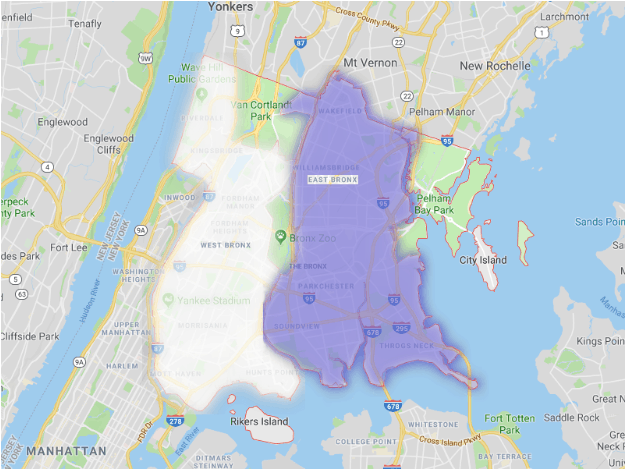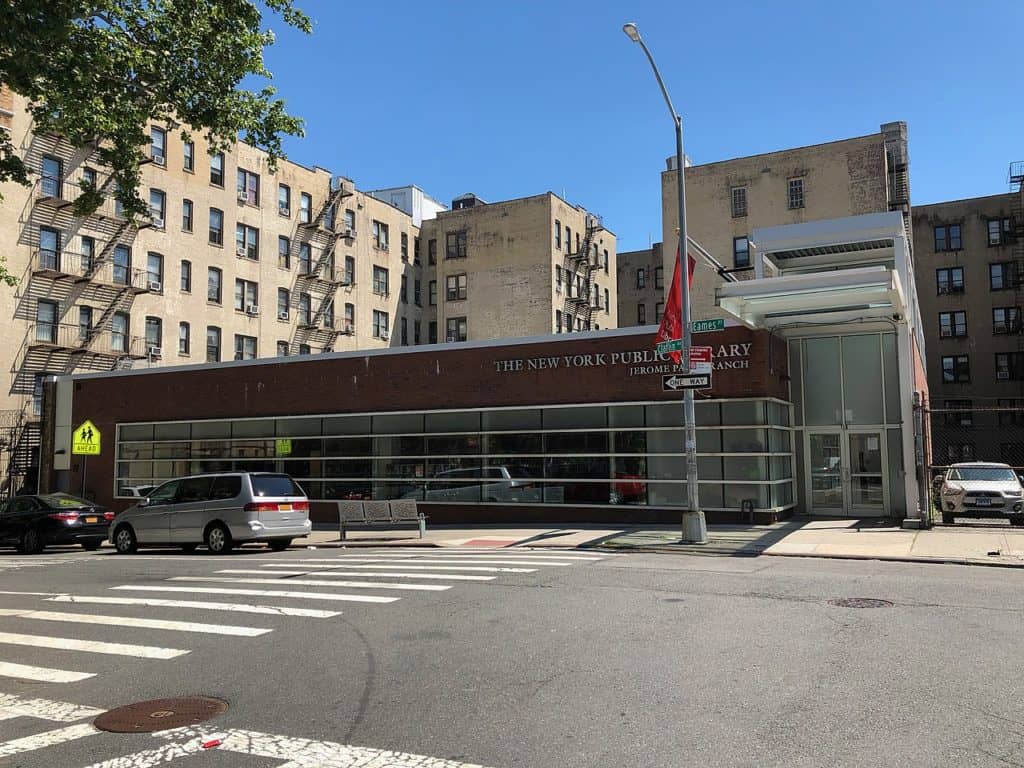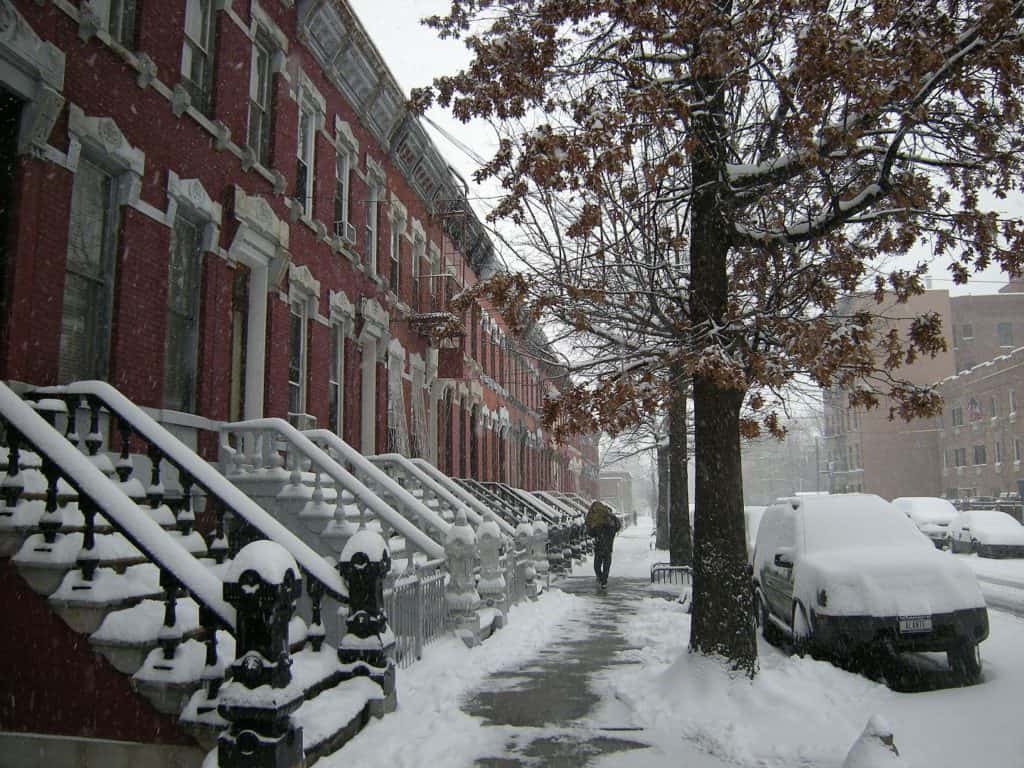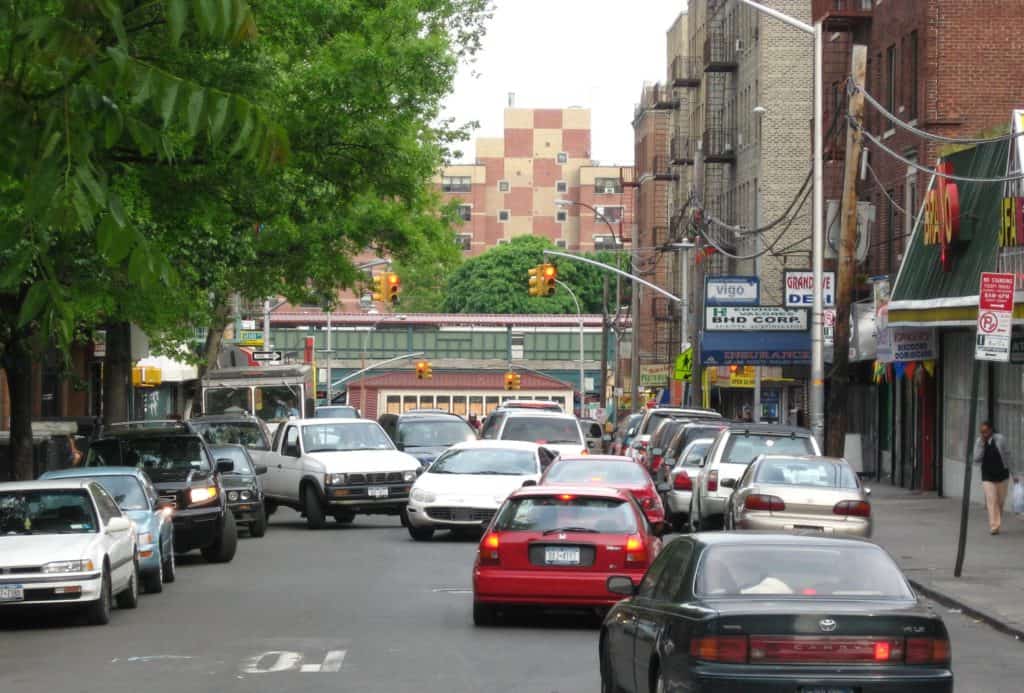
Breaking Down the Bronx: Map of Bronx By Region

The Bronx has historically been broken into two distinct regions: West Bronx and East Bronx, as sectioned by the Bronx River, which runs vertically through the center of the borough.
West Bronx
Settled first, the West Bronx was annexed to New York City in 1874, is decidedly more urban, and has hillier terrain. It can be further divided into the Northwest Bronx and Southwest Bronx, as split by Fordham Road. Those who would like to live in Manhattan but are priced out typically settle in the West Bronx, as well as those with a commute to Manhattan.
East Bronx
The East Bronx is generally suburban and has a more coastal vibe. It was annexed to NYC in 1895 and can be further divided into the Northeast Bronx and Southeast Bronx, as split by Pelham Parkway. Even though West Bronx is closer to Manhattan, commutes are still manageable from some parts of East Bronx, particularly with the addition of ferry service from Soundview to Manhattan, which dropped some commutes from nearly two hours to about 45 minutes.
The Bronx Neighborhoods Guide
Looking at a map of Bronx, you’ll notice it’s not small. In fact, there are more than 50 neighborhoods in the Bronx–that’s a lot to cover. Instead of overloading you with information, we decided to highlight a few of the most popular, up-and-coming, and “safest” parts of the Bronx to help you better identify which areas to target in your search. If something piques your interest, take a page from our tips for first-time homeowners guide and visit the area in person before committing.
1. Bedford Park

The online magazine Curbd describes Bedford Park as “a peaceful enclave in the Bronx.” Situated in the northwest corner of the borough, it was originally a farming community, but the addition of a thoroughbred horse racetrack began attracting the wealthy in the late 1800s. As such, the neighborhood includes a mixture of exquisite three-story Victorian homes and five or six-story apartment buildings, the latter of which is easier to get into. The neighborhood is quite diverse, which makes it easy for anyone to feel at home. However, residents say many schools are currently overcrowded and underperforming, so parents tend to send their children to local parochial schools when they can afford to do so.
2. Belmont

Despite being home to Arthur Avenue, often referred to as the Bronx’s “Little Italy,” Belmont also has strong Puerto Rican and Albanian influences. While many residents still agree it has a small-town feeling, the area gets a massive influx when Fordham University begins session and every weekend when visitors from as far as Connecticut and New Jersey rush in to do their shopping on Arthur Avenue. Belmont is perhaps best known for its rainbow of rowhouses but contains a mix of four, five, and six-story tenements and low-rise apartments too. Moving to Belmont is an excellent decision for those looking for a tight-knit community and affordable housing.
3. Fordham

Named one of Brick Underground’s Best Bronx Neighborhoods, Fordham has experienced much change over the years. It was initially a farming area but then drew in middle-class families from Manhattan, which resulted in the emergence of mass transit. Throughout the 1930s to 1970s, it developed a large Jewish population as well, though many moved away soon after. This was also a difficult time for the neighborhood due to a wave of arson, which damaged and destroyed many of the residential buildings, particularly in low-income areas.
However, the area has been rebuilt, and police forces have been working overtime to clean it up, resulting in major crime reductions over the past several decades. There are some single-family homes and brick rowhouses near the eastern end, but the majority of housing is four and five-story tenements. If you want to be close to well-known destinations like The Bronx Zoo and The New York Botanical Garden, consider moving to Fordham.
4. Highbridge

Highbridge is a unique neighborhood located on a ridge in the Southwest Bronx. When you look at a map of Bronx, you’ll see the Harlem River and Upper Manhattan to the east and Yankee Stadium in the valley. Because of this, Highbridge has been isolated for the most part and escaped gentrification for years. Quite a bit of this comes down to inaccessibility; the terrain made it challenging to build. Ergo, mostly low-rise apartments sprung up where developers could evade the rocks, while single-family homes were perched on hills, often only accessible via staircases.
This leads to the other interesting find within the neighborhood: adjacent streets are connected with staircases too. Though livable space is at a premium, it is simply impossible or cost-prohibitive to build in some areas, but locals made use of those areas, too—by adding gardens and green spaces.
So, with Highbridge being all but removed from most of the Bronx neighborhoods because of terrain, it became a beautiful enclave mainly served by local businesses and full of community pride. At the same time, it boasted some of the lowest rents in the area (and still does), but it also gained a bit of a reputation for being part of the “South Bronx,” a low-income region with a crime problem. Today’s Highbridge has come a long way. While you’re still more likely to find a bodega than a bank, gentrification is creeping in, bringing a slew of services and higher-end living options with it.
5. Hunts Point

This urban peninsula is part of the Southwest Bronx and juts out into the East River. Not surprisingly, the area was once a summering destination for the elite, but it became more industrial in the mid-1900s. Most of the area remains commercial and industrial spaces today, but as you move to the northern end, you’ll find a mix of low-rise apartments as well as some townhouses and brownstones. Recent data shows the median household income in this neighborhood at $31,171 per year, and almost everyone rents. However, the schools perform above the national average, and a good cup of coffee or green space is never far away.
6. Jerome Park

The neighborhood of Jerome Park, which is in the Northwest Bronx, drew attention for hosting the Jerome Park Racetrack in the 1800s. There’s a good mix of pre-war courtyard buildings that suit those who need more square footage without paying traditional NYC rates. Alongside the six-story apartments, you’ll also find a small selection of duplexes and single-family homes. With its beautiful parks, tree-lined streets, and stunning historic homes, Jerome Park offers a peaceful and idyllic setting perfect for families and individuals alike. The neighborhood is also conveniently located near several major transportation hubs, providing easy access to the rest of New York City.
7. Kingsbridge

As another of Brick Underground’s best of the Bronx neighborhoods, Kingsbridge encompasses Kingsbridge Heights and Van Cortlandt Village. It tends to attract those who prefer Manhattan living but find the prices too high. The median household income is just $56,690 per year, but the affordability of Kingsbridge makes it accessible. The neighborhood is located in the Northwest Bronx and hosts a few single-family homes but is mostly well-built and spacious apartments.
8. Morris Park

If Belmont’s Arthur Avenue excites you, you’ll probably like Morris Park too. The Italian population is so strong in this neighborhood that more than 30,000 people flocked to it for an all-day party following the 2006 World Cup. It’s also widely known for its Columbus Day Parade as well as for having some fantastic bakeries and restaurants. Moreover, there’s a multitude of parks, and is often considered one of the cleanest parts of the Bronx.
9. Morrisania

Named after the Manor of Morrisania–or the estate owned by the Morris family, who once owned most of the Bronx–the Morrisania of today is mainly low-income housing with a few brownstones. Morrisania sits in the heart of the Southwest Bronx, and residents say it’s a neighborly place and report that it’s slowly gentrifying, like much of NYC. There are numerous New York City Housing Authority developments in the neighborhood, with the city announcing additional buildings to be used for low-income seniors.
10. Mott Haven

It’s hard to be much closer to Manhattan without actually being in Manhattan when living in Mott Haven. Situated in the Southwest Bronx, the neighborhood was once primarily industrial and treated more like a place to pass through on the way to midtown. However, developers began working on some high-end buildings facing the Harlem River, which kicked the area up a notch, and there are still a fair amount of more moderately priced options as you move inland.
There are also quite a few green spaces, and $10 million of the Downtown Revitalization Initiative was earmarked for the area, too, so it’s got quite a bit going on and more to come soon. Because of this unique mix, Mott Haven is a diverse place that attracts everyone from professionals to families. It’s also worth noting that although Mott Haven once had a reputation for being a bit rough around the edges, it’s presently one of the Bronx neighborhoods with great schools!
11. Parkchester

The Southeast Bronx’s Parkchester is one of the few planned communities in NYC and was one of the first ever built in the United States. Completed in 1942, it was designed by Metropolitan Life to meet the needs of more than 10,000 middle-class families picking up their first rentals, though there’s also a fair mix of single-family homes in the area too.
The name is an amalgamation of the two neighborhoods which came together: Park Versailles and Westchester Heights. The developers were incredibly mindful about incorporating retail and recreational space throughout and also made a point of leaving certain parts untouched. There’s intricate brickwork, hundreds of statuettes, and artistic plaques installed around the neighborhood, giving it a very creative vibe.
One of the most notable features is the Aileen B. Ryan Oval, formerly called the Metropolitan Oval, which is a 2-acre garden topped off with an elegant fountain in the heart of Parkchester, where Unionport Road and Metropolitan Avenue connect. With such beauty and everything one might need within walking distance, why isn’t everyone buzzing about moving to Parkchester?
Unfortunately, ownership changed hands, and care fell by the wayside. About one-third of the apartments were converted to condos, but many failed to sell. During the 1990s, the Parkchester Preservation Company (PPC) was founded. The group purchased the unsold condos as well as commercial space and poured $250 million into restoring the area. Because of this, Parkchester is again operating exactly as intended, and it can be a bit difficult to get into now.
12. Riverdale

Riverdale may have been overlooked for some time because it sits at the northernmost point of the West Bronx, making the transit to midtown a bit of a struggle. However, a map of Bronx shows it is bordered by the Hudson to the west and Van Cortlandt Park to the east, giving ample opportunity to explore and enjoy the outdoors. Plus, the upper west side of Manhattan is less than 30 minutes away, which makes it a unicorn of a neighborhood. If that isn’t enough, it’s rated the #3 best neighborhood to raise a family in New York, the #25 best New York neighborhood overall, and the schools tend to rank pretty well too.
13. Spuyten Duyvil

The neighborhood of Spuyten Duyvil gets its moniker from the Spuyten Duyvil Creek. In Dutch, the name is Spuitende Duivel, which literally translates to “Spouting Devil,” a nod to its strong and unpredictable currents. However, other adaptations suggest the name means “Sprouting Meadow” or even “In Spite of the Devil,” and some don’t even bother taking it that far—they simply consider Spuyten Duyvil to be South Riverdale. Either way, this part of the Bronx is commonly lumped in with Riverdale, making it one of the safest and best places to live in NYC.
Semantics aside, nearly 80% of residents have some level of college education, and the majority of households make over $150,000 per year. There are quite a few co-ops/condos, townhomes, and single-family homes of various architectural styles to choose from, and most of the multi-family properties have doormen. It’s fairly diverse and has just about everything one might need, from quality schools to nightlife options, plus it has several parks. Commutes aren’t too bad—Grand Central is about 20 minutes away.
14. Throgs Neck

Also referred to as Throggs Neck, the peninsula is part of the Southeast Bronx and juts into the East River. It’s one of the quainter neighborhoods with plenty of green spaces and tends to attract a mix of professionals and families. Although the commute isn’t as easy as from some other neighborhoods, Throgs Neck makes up for it with picturesque views and an average safety rating. The housing stock is also quite varied, but the area doesn’t often make lists because it’s so quiet that people tend to overlook it.
15. University Heights

The University Heights name is a nod to the New York University’s Bronx campus, which was built in the area in 1894. Although the building is now part of Bronx Community College, the heritage, history, and moniker remain. Naturally, it initially attracted the upper class. The single-family homes, including a smattering of Victorians, speak to this. As demand increased, both pre-war and post-war, apartments and rowhomes sprung up too. The Northwest Bronx neighborhood is full of parks and backs up to the Harlem River. It’s also served by the 4 train and has a wealth of services and amenities close at hand. While the neighborhood doesn’t get much attention, it attracts those who don’t want a long commute or Manhattan prices but prefer to be close to the action.
16. Woodlawn

Also referred to as “Woodlawn Heights” and sometimes “Little Ireland,” Woodlawn is a sliver of a neighborhood bordered to the east by the Bronx River, the northwest by the Van Cortlandt Park, and south by the Woodlawn Cemetery. Because of its position in relation to the Bronx River, many will say Woodlawn is technically part of the West Bronx. Still, given that it’s removed from all other West Bronx neighborhoods due to the park and cemetery, others argue it’s part of the East Bronx.
While that dispute may never be settled, it is a beautiful place with lots of recreational activities. Residents report that it’s a clean and friendly place where people in every stage of life come together to enjoy the outdoors and dining. However, the primary downside to life in Woodlawn is that it is somewhat removed from the subway system, so buses or sturdy legs are necessary for commuters.
Moving to One of the Bronx Neighborhoods? We Can Help!
With so many diverse parts of the Bronx, we hope this list helped you identify your favorite areas. Once you’ve selected your ideal neighborhood, let Metropolis Movers handle your move to the Bronx. With years of experience as a commercial and residential moving company covering both local and long-distance relocations, our experts can help you get settled in quickly. Contact us for a free quote.


